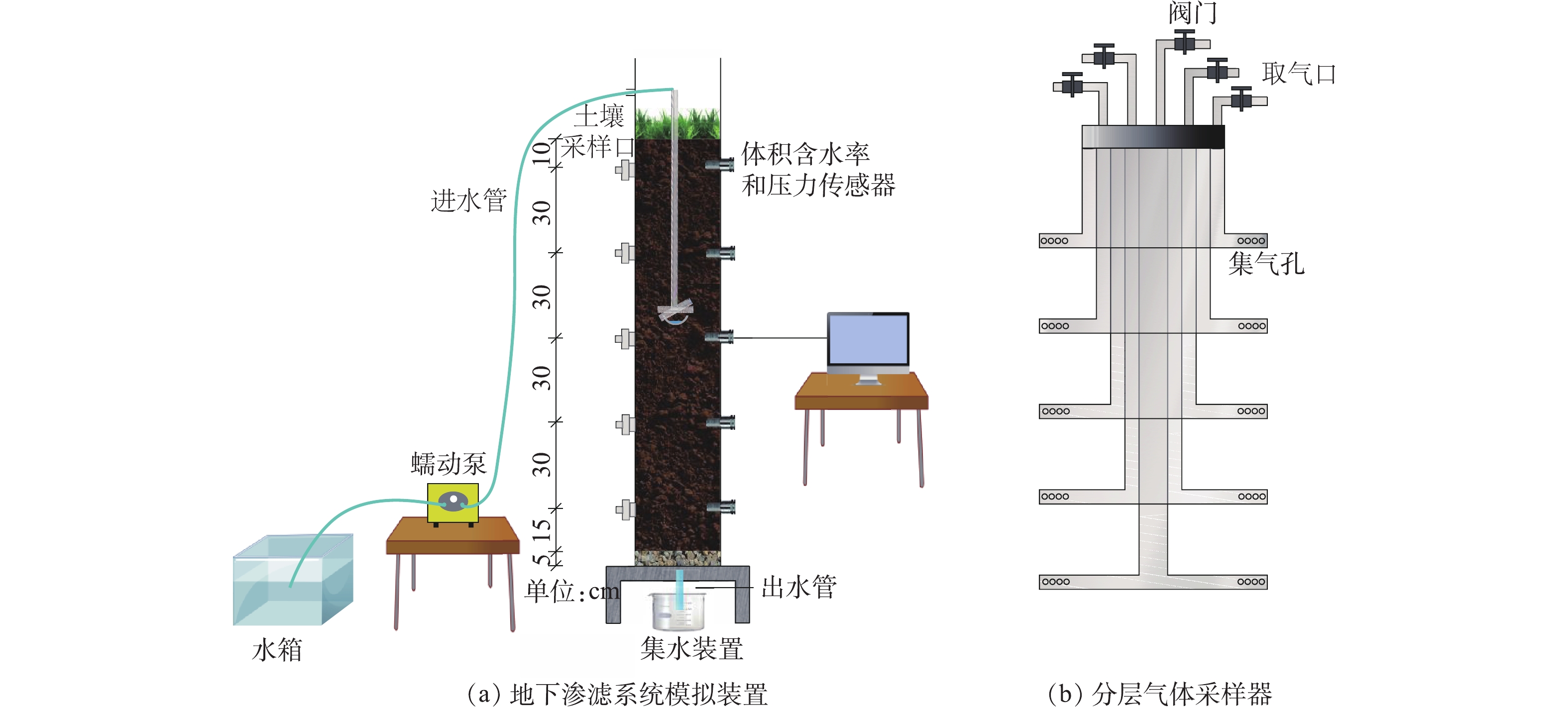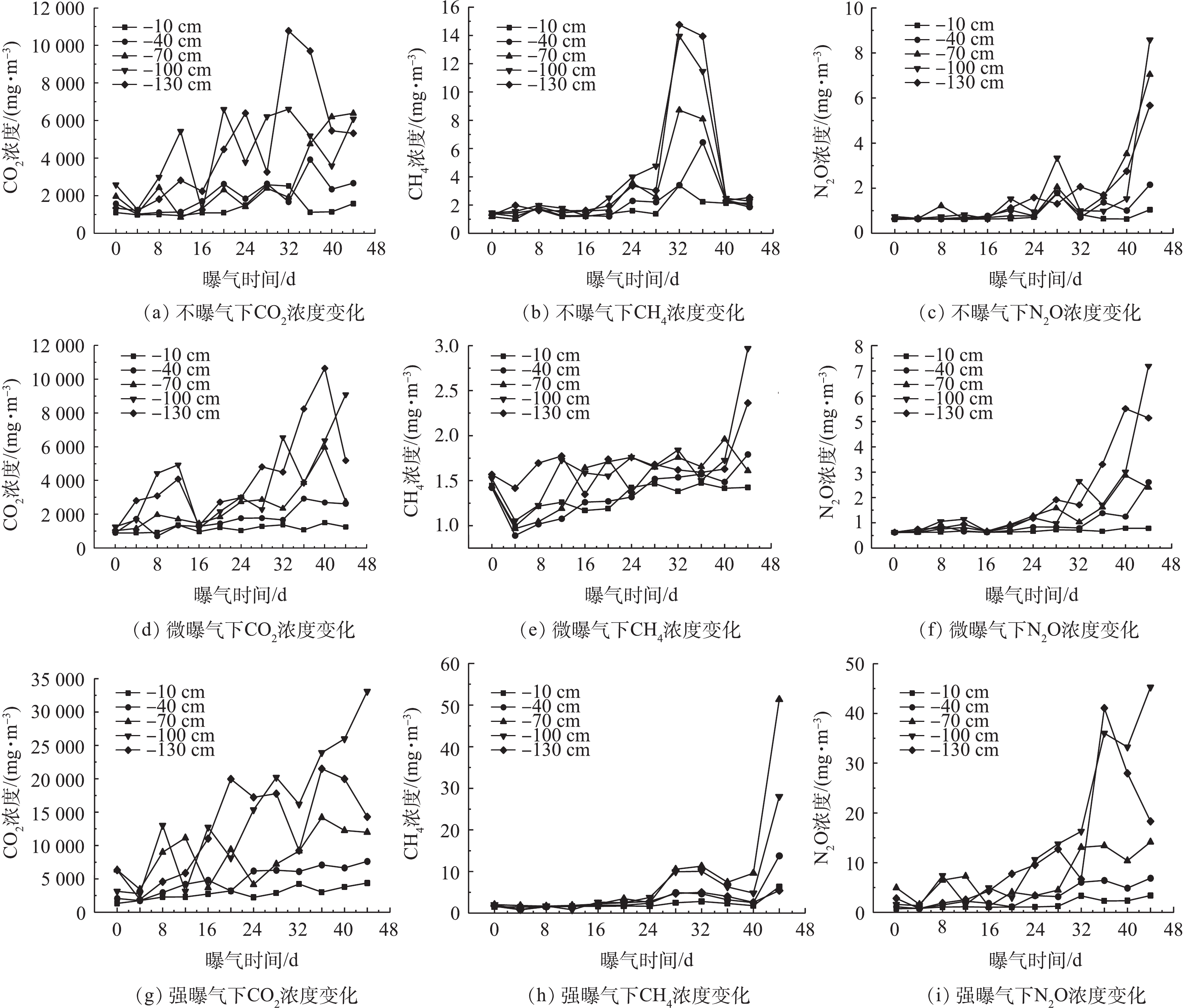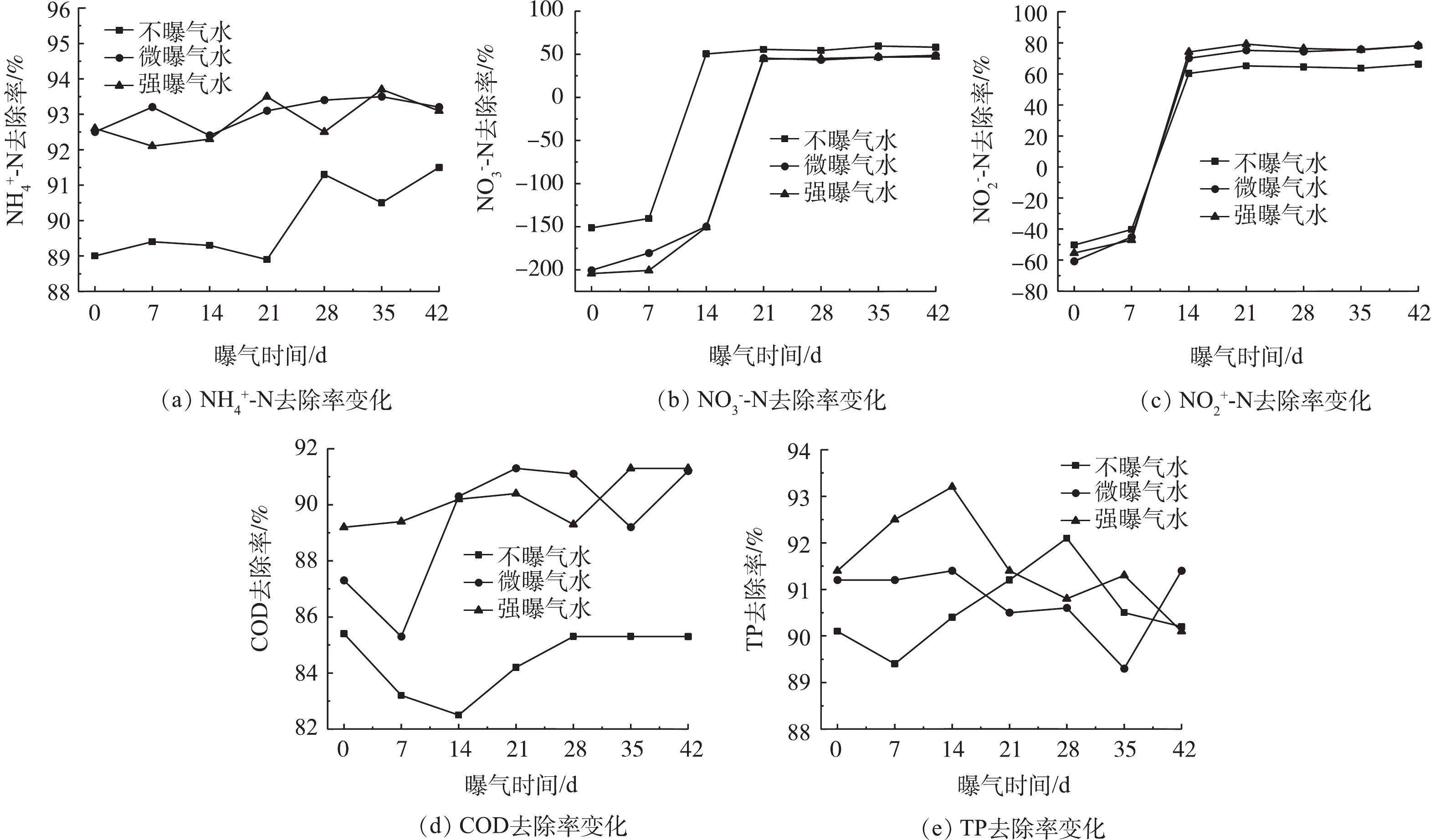-
污水地下渗滤系统(subsurface wastewater infiltration system,SWIS)利用土壤与微生物的联合作用,通过物理、化学、生物反应去除污染物[1]。SWIS具有构造简单、操作维护成本低、污染物去除率高等优点[2]。但是,SWIS长期运行会改变土壤渗透性能,影响出水水质。LI等[3]将长期(7年以上)和短期(1年)运行的SWIS进行比较,结果表明,短期运行SWIS的BOD、COD、SS、
$ {\rm{NH}}_{\rm{4}}^{\rm{ + }}$ -N、TP去除率分别为95.0%、89.1%、98.1%、87.6%和98.4%,长期运行SWIS的BOD、COD、SS、$ {\rm{NH}}_{\rm{4}}^{\rm{ + }}$ -N、TP去除率分别降低至89.6%,87.2%,82.6%,69.1%和74.4%,说明长期运行导致的土壤渗透性、孔隙度及代谢气体积累程度的变化将影响SWIS处理性能。土壤渗透性能降低主要由物理、化学、生物和气体4方面因素造成。粒径较小的悬浮物堆积在基质孔道中,降低渗透性。粒径小于6 μm的颗粒是渗透性降低的主要原因[4]。有机悬浮物不会造成明显的渗透性降低,无机悬浮物更易降低土壤渗透性[5]。悬浮物引起的渗透性降低通常无法得到恢复[6]。污水中的离子与SWIS中原有的离子发生化学反应,可产生不溶性沉淀,其中,碳酸盐和铁化合物是主要的沉淀[7-8]。细菌细胞和生物膜会积累在孔隙空间中,导致孔隙减少和水力传导性降低[9]。影响渗透性能的气体包括进水携带空气和生物代谢气体[10]。进水携带空气是随进水进入系统后截留在系统中的空气,生物代谢气体是微生物呼吸产生的气体。一方面,空气可能积累在孔隙中,另一方面,空气中的氧气会影响生物代谢气体的产生,代谢气体也会积累在孔隙中。进水携带空气和生物代谢气体如果不能及时排出系统,会降低体积含水率,导致渗透性能降低。渗透性能适度降低会增加系统内部非饱和流动区,从而导致污染物处理能力增加;而渗透性能大幅降低会使污水难以通过基质层,污染物处理能力降低[5]。
预处理(过滤沉淀)可以减少进入系统的悬浮物,干湿交替可以恢复孔隙度,酸化可以减少化学沉淀产生[11-12]。然而,研究多集中于防治悬浮物、化学物质和微生物导致的渗透性能降低。由于针对气体对土壤渗透性能的影响的研究鲜有报道,实际工程中也没有针对气体的有效防治方法。因此,本研究对气体导致的SWIS渗透性变化及污染物处理效果进行了初步探究,为气体堵塞及其防治奠定基础。对SWIS进水采用了不同曝气处理(不曝气、微曝气、强曝气),研究了不同的曝气量对SWIS渗透系数、体积含水率、代谢气体释放量和污染物(COD、
$ {\rm{NH}}_{\rm{4}}^{\rm{ + }}$ -N、$ {\rm{NO}}_{\rm{3}}^{\rm{ - }}$ -N、$ {\rm{NO}}_{\rm{2}}^{\rm{ - }}$ -N和TP)去除率的影响,以期为研究气体堵塞及其预防提供参考。 -
进水为人工配制的生活污水,水质特征如下:COD (330.21±7) mg·L−1,
${\rm{NO}}_3^{-} $ -N (3.12±0.1) mg·L−1,${\rm{NO}}_2^{-} $ -N (0.40±0.004) mg·L−1,${\rm{NH}}_4^{+} $ -N (49.08±0.6) mg·L−1,TP (4.0±0.3) mg·L−1。对进水进行不同程度的曝气处理,形成不曝气水、微曝气水和强曝气水。不曝气水为人工配制的生活污水,不经过任何处理,气体含量为0%。微曝气水使用45 L·min−1的空气泵对污水进行持续曝气,气体含量为3.6%。强曝气水使用70 L·min−1的空气泵对污水进行持续曝气,气体含量为6.3%。气体含量测量方法使用杜磊[13]的方法。
-
SWIS模拟装置如图1所示。尺寸为180 cm×29 cm(高×直径)。基质分为2层,底部为5 cm的砾石,砾石上方为145 cm的混合基质。混合基质由沙、炉渣和农田土按1∶2.5∶6.5的比例混合而成,孔隙度为0.55。进水由蠕动泵泵送,通过“十”字布水管(土壤下65 cm处)和不透水皿散水。在土壤下10、40、70、100、130 cm处放置体积含水率传感器和压力传感器,连接电脑读取数据。系统下方的集水装置收集出水。在图1(a)的基础上增加分层气体采样器(图(1b))。将集气管埋设于图1(a)土柱的土壤下方,各层集气管之间相距30 cm,上部取气口位于土壤上方,平时密封,只在采样时短暂开启。用分层气体采样器采集土壤下10、40、70、100、130 cm处的气体。
-
分别用SWIS处理不曝气水、微曝气水和强曝气水,进水负荷为14 cm·d−1,持续44 d,用电脑记录体积含水率和压力的数据;用集水装置收集出水,记录出水流量;定期采集气体样品和出水样品。
-
气体样品由气相色谱仪(Agilent 7890B)测定。根据文献中的监测分析方法[14]测定水质:化学需氧量(COD)使用重铬酸钾氧化法测定;氨氮(
$ {\rm{NH}}_{\rm{4}}^{\rm{ + }}$ -N)使用纳氏试剂光度法测定;硝态氮($ {\rm{NO}}_{\rm{3}}^{\rm{ - }}$ -N)使用紫外分光光度法测定;亚硝态氮($ {\rm{NO}}_{\rm{2}}^{\rm{ - }}$ -N)使用分光光度法测定;总磷(TP)使用钼酸胺分光光度法测定。渗透系数由达西定律[15]计算,计算方法如式(1)所示。
式中:k为渗透系数,cm·s−1;Q为流量,m3·s−1;l为相邻压力计的垂直距离,cm;A为横截面积,m2;h为压头变化,m。
本研究使用SPSS软件进行相关分析,文中所有相关系数均为排除时间变量后的Pearson相关系数。
-
不同曝气处理下渗透系数随时间的变化如图2所示。可以看出,由于SWIS运行时间较短,不同曝气处理下的SWIS均没有出现土壤堵塞现象,但是曝气量影响了不同深度处的渗透系数。SWIS的渗透系数为4.167×10−5~1.389×10−3 cm·s−1[16]。渗透系数过高,SWIS持水能力降低,污染物未经有效处理就被排出系统;渗透系数过低,SWIS土壤基质堵塞。PAN等[17]认为,渗透系数低于3.5×10−4 cm·s−1时,SWIS会出现堵塞现象。实验中不同深度处的渗透系数均高于3.5×10−4 cm·s−1,没有发生堵塞现象。在−40~−10 cm处,不同曝气处理的渗透系数均为最低。在−70~−40 cm处,不曝气系统达到稳定的渗透系数高于初始渗透系数,微曝气和强曝气系统达到稳定的渗透系数低于初始渗透系数。在−100~−70 cm处,不曝气系统的渗透系数波动较大,微曝气和强曝气系统的渗透系数几乎没有波动;该深度微曝气和强曝气系统的渗透系数低于不曝气系统。在−130~−100 cm处,不同曝气处理下,系统达到稳定的渗透系数均高于初始渗透系数,渗透系数稳定后,强曝气系统的渗透系数较高。
从图2还可以看出,不曝气、微曝气和强曝气系统渗透系数分别在大约10、14、22 d后达到稳定,这说明曝气量越大,SWIS渗透系数达到稳定所需时间越长。这主要归因于以下2个方面:一方面,曝气量越大,进水携带空气越多;另一方面,曝气为好氧微生物呼吸产生CO2提供了有利条件,导致SWIS内部气体含量增加,从而使得系统达到平衡所需时间更长。
曝气量与SWIS渗透系数的相关性分析如表1所示。将时间变量的影响排除后,分析曝气量与渗透系数的相关关系。P<0.05说明两者有显著的相关关系。相关性强弱用相关系数表示,相关系数的绝对值越大,相关性越强。曝气量与 −70~−40 cm处的渗透系数不存在相关关系,与−130~−100、−100~−70 cm、−40~−10 cm处的渗透系数有显著的相关关系。其中,曝气量与−130~−100、−40~−10 cm处的渗透系数是正相关关系,与−100~−70 cm处的渗透系数是负相关关系。曝气主要降低了−100~−70 cm深度处的渗透系数。进水通过布水管(土壤下65 cm处)进入系统后,少量污水向上流动,大量污水在毛细作用和重力作用下向下流动,首先影响−100~−70 cm处的土壤,导致−100~−70 cm处的渗透系数降低。
-
不同曝气处理下体积含水率随时间的变化见图3。从图3可以看出,微曝气和强曝气系统体积含水率变化规律相似,与不曝气系统体积含水率变化规律差异较大。在微曝气和强曝气系统中,−100 cm处的体积含水率较低,−10、−40和−70 cm处的体积含水率较高;曝气量越大,各层体积含水率越低。在不曝气系统中,−100、−40和−10 cm处的体积含水率较高,在0.90以上;在−70 cm处的体积含水率开始缓慢波动下降,35 d后迅速下降至0.80。
由图2和图3可知,在不同曝气处理下,渗透系数在实验中后期达到稳定,体积含水率在整个实验阶段不断变化,这表明体积含水率影响实验前期的渗透系数,与实验中后期的渗透系数之间的关系不明显,这与BECKWITH等[18]的研究结果不同。他们的研究对象是泥炭土,孔隙度为0.96~0.97,体积含水率为0.80~0.85,体积含水率稍微变化可能会引起土壤结构的改变,影响渗透系数,所以体积含水率与渗透系数的相关性很强。而本研究的对象为SWIS,主要基质是农田土、炉渣和沙的混合基质,孔隙度为0.55,体积含水率为0.80~1.00,土壤结构比较稳定,孔隙中气体含量变化与水流移动达到平衡后,渗透系数不再变化。
曝气量与SWIS体积含水率的相关性分析如表2所示。曝气量与−10 cm处的体积含水率不存在相关关系,与−100、−70、−40 cm处的体积含水率有显著的相关关系。其中,曝气量程度与−100、−40 cm处的体积含水率为较强的负相关关系,但与−70 cm处的体积含水率为较强的正相关关系。
-
不同曝气处理下代谢气体浓度随时间的变化见图4。可以看出,不曝气和微曝气系统中各深度处的CO2浓度相近,为1 000~12 000 mg·m−3;强曝气系统中,CO2浓度较高,为1 000~35 000 mg·m−3。与不曝气系统相比,微曝气系统降低了CH4的浓度,这是因为曝气增加了氧气浓度,抑制了产甲烷菌的生长繁殖。在强曝气系统中,24 d内CH4浓度很低,24~40 d略有增加,40~44 d迅速增加。尽管曝气抑制了产甲烷菌的生长繁殖,但是CH4积累在系统中,没有及时释放,导致强曝气系统中最终的CH4浓度远高于不曝气和微曝气系统。微曝气系统中N2O浓度略低于不曝气系统,强曝气系统中N2O浓度远高于不曝气和微曝气系统。N2O的产生途径有硝化作用、反硝化作用和共反硝化作用。其中,在共反硝化作用中,N2O的一个N原子来源于
$ {\rm{NO}}_{\rm{2}}^{\rm{ - }}$ -N,另一个N原子来源于其他氮化合物[19]。曝气增加好氧区,促进硝化作用产生N2O,同时硝化作用过程中产生的$ {\rm{NO}}_{\rm{2}}^{\rm{ - }}$ -N为共反硝化作用提供N元素,抑制反硝化作用产生N2O。分析认为,不曝气系统中反硝化是产生N2O的主要途径。在微曝气系统中,较低的曝气量减少了反硝化产生的N2O,但对硝化和共反硝化作用促进作用不强,所以微曝气系统N2O浓度较低。在强曝气系统中,较高的曝气量会促进硝化和共反硝化作用,尽管反硝化产生的N2O减少,硝化和共反硝化作用产生大量N2O,强曝气系统N2O浓度高。从图4还可以看出,在不同曝气处理下,CO2、CH4、N2O在−10 cm和−40 cm处的浓度都较低,在−70、−100和−130 cm处的浓度较高,这说明代谢气体主要影响系统中下部的渗透系数。−10 cm和−40 cm接近土壤表层,气体容易通过基质孔隙释放到大气中。−70、−100和−130 cm位于系统中下部,其中微生物代谢产生的气体一部分沿基质孔道向上移动,释放到大气中,一部分随水流从出水口流出,剩下的积累在基质孔隙中。在−70、−100 cm处,生物代谢气体与进水携带空气共同积累,降低了−100~−70 cm处的渗透系数。在−130 cm处,生物代谢气体浓度较高,但该深度接近出水口,气体易释放,此外,该深度离进水口较远,进水携带空气少,气体对渗透系数影响较小。
曝气量与CO2、CH4、N2O浓度的相关性分析如表3所示。曝气量与各深度处的CH4浓度不存在相关关系,与各深度处的CO2、N2O浓度有显著的相关关系。其中,曝气量与−100、−70、−40 cm处的CO2、N2O浓度相关系数更高,与−130、−10 cm处的CO2、N2O浓度相关系数较低,这说明曝气对接近进水位置的−100、−70、−40 cm处的CO2、N2O浓度影响较大,而对接近土壤表层的−10 cm处和接近出水口的−130 cm处的CO2、N2O浓度影响较小。
-
不同曝气处理下出水污染物去除率随时间的变化结果见图5。从图5可以看出,
$ {\rm{NH}}_{\rm{4}}^{\rm{ + }}$ -N,COD和TP的去除效果较好,$ {\rm{NO}}_{\rm{3}}^{\rm{ - }}$ -N,$ {\rm{NO}}_{\rm{2}}^{\rm{ - }}$ -N的去除效果较差。生物硝化-反硝化是SWIS脱氮的主要途径[20]。曝气为好氧硝化作用提供了有利环境,抑制了厌氧反硝化作用,因此,微曝气和强曝气系统的$ {\rm{NH}}_{\rm{4}}^{\rm{ + }}$ -N和$ {\rm{NO}}_{\rm{2}}^{\rm{ - }}$ -N去除率均高于不曝气系统,微曝气和强曝气系统的$ {\rm{NO}}_{\rm{3}}^{\rm{ - }}$ -N去除率均低于不曝气系统。$ {\rm{NO}}_{\rm{3}}^{\rm{ - }}$ -N和$ {\rm{NO}}_{\rm{2}}^{\rm{ - }}$ -N的初始浓度高于进水,这是因为$ {\rm{NH}}_{\rm{4}}^{\rm{ + }}$ -N在亚硝化菌和硝化菌作用下所产生的$ {\rm{NO}}_{\rm{2}}^{\rm{ - }}$ -N和$ {\rm{NO}}_{\rm{3}}^{\rm{ - }}$ -N积累在SWIS中。COD去除的主要途径是有机物降解。好氧异养细菌在有机物好氧降解中起着重要作用,充足的供氧能有效提高好氧微生物降解有机物的效率[21]。曝气提高了SWIS中溶解氧浓度,有利于耗氧的有机物(以COD计)降解,所以微曝气和强曝气系统中的COD去除率高于不曝气系统。TP去除的主要途径是物理化学吸附[22]。TP去除率在89%以上。曝气对物理化学吸附的影响作用较小,因此,不曝气、微曝气和强曝气系统的TP去除率相近。曝气量与污染物去除率的相关性分析如表4所示。曝气量与
$ {\rm{NO}}_{\rm{3}}^{\rm{ - }}$ -N、$ {\rm{NO}}_{\rm{2}}^{\rm{ - }}$ -N、TP去除率不存在相关关系,与$ {\rm{NH}}_{\rm{4}}^{\rm{ + }}$ -N、COD去除率有显著的相关关系。曝气量与$ {\rm{NH}}_{\rm{4}}^{\rm{ + }}$ -N、COD去除率有显著的正相关关系。 -
1)曝气量与−130~−100、−40~−10 cm处的渗透系数有较强的正相关关系,与−100~−70 cm处的渗透系数有较强的负相关关系,与−70~−40 cm处的渗透系数不存在相关关系,这说明曝气主要降低了−100~−70 cm深度处的渗透系数。
2)曝气降低了−100 cm处和−40 cm处的体积含水率,增加了−70 cm处的体积含水率,对−10 cm处的体积含水率几乎没有影响。其中,−100 cm处的体积含水率的减少可能是导致−100~−70 cm处的渗透系数下降的原因。
3)曝气量与各深度处的CH4释放浓度不存在相关关系,与各深度处的CO2、N2O释放浓度为正相关关系;生物代谢气体在系统中下部(−130、−100和−70 cm处)的浓度高于系统上部(−40 cm和−10 cm)。生物代谢气体主要影响系统中下部的渗透系数。
4)曝气增加了SWIS对
$ {\rm{NH}}_{\rm{4}}^{\rm{ + }}$ -N、COD的去除率,与$ {\rm{NO}}_{\rm{3}}^{\rm{ - }}$ -N、$ {\rm{NO}}_{\rm{2}}^{\rm{ - }}$ -N、TP去除率不存在相关关系。曝气会增加短期运行的SWIS整体污染物处理效果,但对长期运行的SWIS处理效果的影响还需要进一步的研究。
曝气对污水地下渗滤系统渗透性及处理性能的影响
Effects of aeration on permeability and treatment performance of subsurface wastewater infiltration system
-
摘要: 针对气体影响地下渗滤系统的渗透性及污水处理效果的问题,用地下渗滤系统处理不同曝气程度的生活污水,研究曝气对不同深度基质理化性质(渗透系数、体积含水率、气体类型及浓度)和出水水质的影响。结果表明,曝气增加了−130~−100、−40~−10 cm处的渗透系数,降低了−100~−70 cm处的渗透系数,与−70~−40 cm处的渗透系数不存在相关关系;曝气增加了−70 cm处的体积含水率,降低了−100 cm和−40 cm处的体积含水率,对−10 cm处的体积含水率几乎没有影响;曝气增加了各深度处的CO2、N2O释放浓度,与各深处的CH4释放浓度不存在相关关系;曝气增加了
$ {\rm{NH}}_{\rm{4}}^{\rm{ + }}$ -N和COD去除率,与$ {\rm{NO}}_3^{\rm{ - }}$ -N、$ {\rm{NO}}_2^{\rm{ - }}$ -N和TP去除率不存在相关关系。探明了气体对地下渗滤系统处理性能的影响,为气体堵塞及其预防提供了参考。Abstract: In order to identify the effects of gas on the soil permeability and sewage treatment of subsurface wastewater treatment system (SWIS), domestic wastewater with different aeration treatment was introduced into a set of SWIS to study the effect of aeration on the physicochemical properties (permeability coefficient, volumetric water content, gas types and concentrations) of the matrix at different depths and effluent quality. The results indicated that aeration improved the permeability coefficients at −130~−100 cm and −40~−10 cm, reduced the permeability coefficient at −100~−70 cm, had an insignificant correlation with the permeability coefficient at −70~−40 cm. Meanwhile, the aeration elevated the volumetric water content at −70 cm, reduced the volumetric water content at −100 cm and −40 cm, had slight influence on the volumetric water content at −10 cm. Aeration improved the releasing concentrations of CO2 and N2O at different depths, and had an insignificant correlation with CH4 releasing concentrations. Aeration treatment of raw water improved the removal rates of$ {\rm{NH}}_{\rm{4}}^{\rm{ + }}$ -N, COD and TP, reduced$ {\rm{NO}}_3^{\rm{ - }}$ -N removal rate, and had no correlation with$ {\rm{NO}}_2^{\rm{ - }}$ -N removal. The effects of gas on SWIS were preliminarily identified, which provided references for further research on gas clogging and its prevention. -

-
图 5 不同曝气处理下出水
$ {{\bf{NH}}_{\rm{4}}^{\rm{ + }}{\text{-}}\bf{N}} $ 、$ {{\bf{NO}}_{\rm{3}}^{\rm{ - }}{\text{-}}\bf{N}}$ 、$ { {\bf{NO}}_{\rm{2}}^{\rm{ - }}{\text{-}}\bf{N}}$ 、COD和TP去除率随时间的变化Figure 5. Change in
$ { {\rm{NH}}_{\rm{4}}^{\rm{ + }}{\text{-}}\text{N}}$ ,${ {\rm{NO}}_{\rm{3}}^{\rm{ - }}{\text{-}}\text{N}}$ ,$ {{\rm{NO}}_{\rm{2}}^{\rm{ - }}{\text{-}}\text{N}}$ , COD and TP removal with time at different aeration表 1 曝气量与渗透系数的相关分析
Table 1. Correlation analysis of aeration andpermeability coefficient
深度/cm 相关系数 P −130~−100 0.536 0 −100~−70 −0.887 0 −70~−40 0.071 0.413 −40~−10 0.951 0 表 2 曝气量与体积含水率的相关分析
Table 2. Correlation analysis of aeration andvolume water content
深度/cm 相关系数 P −100 −0.745 0 −70 0.629 0 −40 −0.747 0 −10 0.082 0.347 表 3 曝气量与气体浓度的相关分析
Table 3. Correlation analysis of aerationand gas concentrations
深度/cm CO2浓度 CH4浓度 N2O浓度 相关系数 P 相关系数 P 相关系数 P −130 0.572 0 −0.235 0.174 0.489 0.003 −100 0.578 0 0.12 0.492 0.511 0.002 −70 0.624 0 0.261 0.131 0.555 0.001 −40 0.628 0 0.185 0.287 0.572 0 −10 0.576 0 0.171 0.327 0.473 0.004 表 4 曝气量与污染物去除率的相关分析
Table 4. Correlation analysis of aeration andpollutants removal
污染物 相关系数 P $ {\rm{NH}}_{\rm{4}}^{\rm{ + }}$ -N
0.854 0 $ {\rm{NO}}_{\rm{3}}^{\rm{ - }}$ -N
−0.384 0.094 $ {\rm{NO}}_{\rm{2}}^{\rm{ - }}$ -N
0.095 0.689 COD 0.88 0 TP 0.414 0.07 -
[1] JIANG Y, SUN Y, PAN J, et al. Use of dewatered sludge as microbial inoculum of a subsurface wastewater infiltration system: Effect on start-up and pollutant removal[J]. Water SA, 2017, 43(4): 595-601. doi: 10.4314/wsa.v43i4.07 [2] QIN W, DOU J, DING A, et al. A study of subsurface wastewater infiltration systems for distributed rural sewage treatment[J]. Environmental Technology, 2014, 35(16): 2115-2121. doi: 10.1080/09593330.2014.894579 [3] LI Y H, LI H B, PAN J, et al. Performance evaluation of subsurface wastewater infiltration system in treating domestic sewage[J]. Water Science and Technology, 2012, 65(4): 713-720. doi: 10.2166/wst.2012.905 [4] SIRIWARDENE N, DELETIC A, FLETCHER T. Clogging of stormwater gravel infiltration systems and filters: Insights from a laboratory study[J]. Water Research, 2007, 41(7): 1433-1440. doi: 10.1016/j.watres.2006.12.040 [5] 张建, 邵长飞, 黄霞, 等. 污水土地处理工艺中的土壤堵塞问题[J]. 中国给水排水, 2003, 19(3): 17-20. doi: 10.3321/j.issn:1000-4602.2003.03.006 [6] 赖兰萍. 土地渗滤系统处理村镇生活污水的实验研究[D]. 南昌: 江西理工大学, 2009. [7] LARROQUE F, FRANCESCHI M. Impact of chemical clogging on de-watering well productivity: Numerical assessment[J]. Environmental Earth Sciences, 2011, 64(1): 119-131. doi: 10.1007/s12665-010-0823-9 [8] 许增光, 杨雪敏, 柴军瑞. 考虑化学淤堵作用的尾矿砂渗透系数变化规律研究[J]. 水文地质工程地质, 2016, 43(4): 26-29. [9] AAL G Z A, ATEKWANA E A, ATEKWANA E A. Effect of bioclogging in porous media on complex conductivity signatures[J]. Journal of Geophysical Research Biogeosciences, 2015, 115(3): 65-65. [10] HEILWEIL V M, SOLOMON D K, PERKINS K S, et al. Gas-partitioning tracer test to quantify trapped gas during recharge[J]. Groundwater, 2004, 42(4): 589-600. doi: 10.1111/j.1745-6584.2004.tb02627.x [11] 路莹. 北京平谷地区雨洪水地下回灌堵塞机理分析与模拟研究[D]. 长春: 吉林大学, 2009. [12] HUA G, ZENG Y, ZHAO Z, et al. Applying a resting operation to alleviate bioclogging in vertical flow constructed wetlands: An experimental lab evaluation[J]. Journal of Environmental Management, 2014, 136(8): 47-53. [13] 杜磊. 含水层回灌过程中的气相堵塞实验研究[D]. 济南: 济南大学, 2016. [14] 国家环境保护总局. 水和废水监测分析方法[M]. 4版. 北京: 中国环境科学出版社, 2002. [15] REDDI L N, XIAO M, HAJRA M G, et al. Physical clogging of soil filters under constant flow rate versus constant head[J]. Canadian Geotechnical Journal, 2005, 42(3): 804-811. doi: 10.1139/t05-018 [16] 孙铁珩, 李宪法. 城市污水自然生态处理与资源化利用技术[M]. 北京: 化学工业出版社, 2006. [17] PAN J, YU L. Characteristics of subsurface wastewater infiltration systems fed with dissolved or particulate organic matter[J]. International Journal of Environmental Science and Technology, 2015, 12(2): 479-488. doi: 10.1007/s13762-013-0408-8 [18] BECKWITH C W, BAIRD A J. Effect of biogenic gas bubbles on water flow through poorly decomposed blanket peat[J]. Water Resources Research, 2001, 37(3): 551-558. doi: 10.1029/2000WR900303 [19] SPOTT O, FLORIAN STANGE C. Formation of hybrid N2O in a suspended soil due to co-denitrification of NH2OH[J]. Journal of Plant Nutrition and Soil Science, 2011, 174(4): 554-567. doi: 10.1002/jpln.201000200 [20] 李英华, 李海波, 王鑫, 等. 生物填料地下渗滤系统对生活污水的脱氮[J]. 环境工程学报, 2013, 7(9): 3369-3374. [21] ONG S A, UCHIYAMA K, INADAMA D, et al. Performance evaluation of laboratory scale up-flow constructed wetlands with different designs and emergent plants[J]. Bioresource Technology, 2010, 101(19): 7239-7244. doi: 10.1016/j.biortech.2010.04.032 [22] BROOKS A S, ROZENWALD M N, GEOHRING L D, et al. Phosphorus removal by wollastonite: A constructed wetland substrate[J]. Ecological Engineering, 2000, 15(1): 121-132. -










 下载:
下载:











